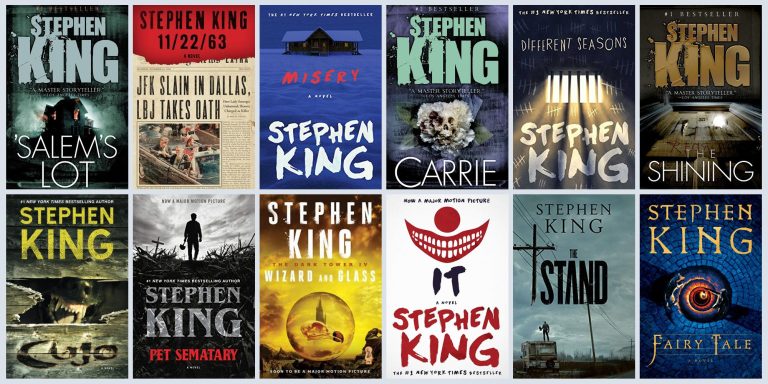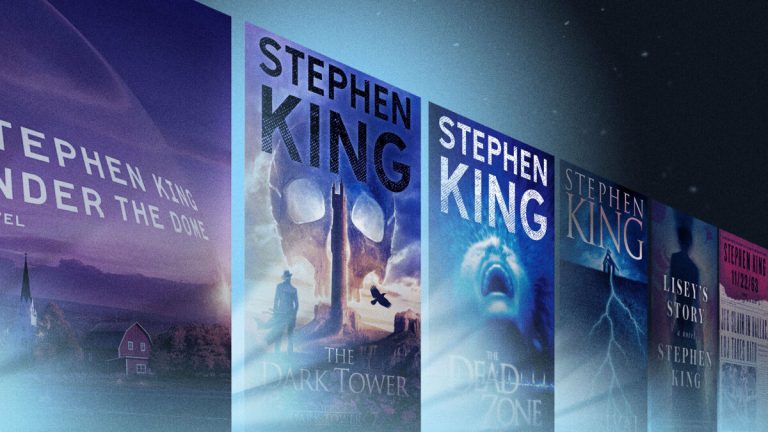Stephen King Books Decoded: A Guide To Unraveling The Dark Tales
If you’ve ever delved into the dark and twisted world of Stephen King’s books, you know that unraveling the mysteries within his pages can be both exhilarating and terrifying. With each turn of the page, you’re transported to a realm where the ordinary becomes extraordinary, and the unimaginable becomes real. But fear not, dear reader, for I am here to guide you through the tangled webs of Stephen King’s mind and help you decode the secrets hidden within his gripping tales of horror and suspense.
In this guide, aptly titled “Stephen King Books Decoded: A Guide to Unraveling the Dark Tales,” we will embark on a journey through the twisted corridors of King’s imagination. From the spine-chilling horrors of “It” to the psychological rollercoaster of “The Shining,” we will explore the themes, symbolism, and underlying messages that make each of his books a masterpiece in its own right. So grab your flashlight and prepare to navigate the labyrinthine depths of Stephen King’s literary universe. Together, we will unlock the secrets that lie within and gain a deeper understanding of the man who has become a legend in the realm of horror fiction.
Are you a fan of Stephen King’s dark and thrilling novels? Look no further! In this comprehensive guide, we decode the hidden meanings and symbols behind King’s most popular books. From “The Shining” to “It,” we delve into the twisted worlds created by this master of horror. Gain a deeper understanding of the themes and motifs that make King’s stories so captivating. Whether you’re a hardcore fan or new to his work, this guide will enhance your reading experience and leave you craving more of King’s chilling tales.

Stephen King Books Decoded: A Guide to Unraveling the Dark Tales
Stephen King is a renowned author known for his gripping and chilling tales. His books have captivated readers for decades, taking them on thrilling journeys through the depths of darkness and the complexities of the human psyche. In this article, we’ll delve into the world of Stephen King’s books, decoding their themes, unraveling their mysteries, and exploring the genius behind the master storyteller.
The Power of Fear and the Supernatural
Stephen King’s novels often explore the power of fear and the supernatural. Through his unique storytelling, King taps into our deepest fears, taking us on terrifying adventures that keep us on the edge of our seats. One of his most iconic works, “It,” tells the story of a group of childhood friends who must confront their deepest fears manifested in the form of a malevolent clown. This novel explores themes of trauma, friendship, and the power of facing one’s fears head-on.
In addition to fear, King’s novels are often imbued with supernatural elements that add an extra layer of intrigue. From haunted houses to demonic possessions, King weaves supernatural elements seamlessly into his narratives, creating a sense of unease and suspense that keeps readers hooked. His ability to blend the ordinary with the extraordinary is what sets his books apart and makes them so compelling.
The Influence of Childhood
Childhood plays a significant role in many of Stephen King’s novels. He often explores the impact of childhood experiences on adult lives, delving into themes of trauma, resilience, and the lasting effects of the past. In “The Shining,” the protagonist’s traumatic childhood experiences in the haunted Overlook Hotel resurface when he becomes the caretaker, leading to a descent into madness. This exploration of childhood trauma adds depth and psychological complexity to King’s works.
Moreover, King’s portrayal of children as protagonists adds an element of vulnerability and innocence to his stories. In novels like “Carrie” and “Firestarter,” young characters with supernatural abilities navigate their extraordinary circumstances while grappling with the challenges of adolescence. King’s ability to capture the essence of childhood and the struggles of growing up resonates with readers of all ages.
Table: A Comparison of Stephen King’s Dark Tales
To further understand the breadth and depth of Stephen King’s books, let’s take a closer look at a comparison of some of his most popular dark tales:
| Book Title | Genre | Themes Explored |
|—————–|—————–|———————|
| “The Stand” | Post-Apocalyptic| Good vs. Evil |
| “Misery” | Psychological | Obsession |
| “Pet Sematary” | Horror | Death and Grief |
| “The Dark Tower”| Fantasy | Quest for Redemption|
This table provides a glimpse into the diverse range of genres and themes that Stephen King explores in his books. Each novel offers a unique experience, showcasing King’s versatility as a writer.
The Role of Setting in Stephen King’s Novels
Setting plays a crucial role in Stephen King’s novels, often becoming a character in itself. Whether it’s the eerie town of Derry in “It” or the isolated Overlook Hotel in “The Shining,” King’s vivid descriptions bring the locations to life, immersing readers in a world where the line between reality and the supernatural blurs. The atmospheric settings add to the overall sense of unease and make the stories more immersive and captivating.
In “The Dark Tower” series, King creates a vast and intricate universe that spans multiple dimensions and realities. The different settings, from modern-day New York City to the decaying Mid-World, contribute to the epic nature of the story and provide a rich backdrop for the characters’ journeys.
The King of Character Development
One of Stephen King’s greatest strengths as a writer is his ability to develop complex and relatable characters. Each character in his novels is meticulously crafted, with their own unique motivations, flaws, and fears. As readers, we become emotionally invested in their journeys, rooting for their triumphs and fearing their downfalls.
King’s attention to detail in character development allows us to connect with the protagonists on a deeper level. Whether it’s the tormented writer in “The Shining” or the resilient young girl in “Carrie,” King’s characters are multidimensional and often mirror the complexities of real-life individuals. This aspect of his storytelling adds depth and authenticity to his narratives, making them all the more compelling.
In conclusion, Stephen King’s books are a treasure trove of dark tales that delve into the depths of fear, supernatural phenomena, and the complexities of the human condition. Through his masterful storytelling, he invites readers into worlds that are both terrifying and captivating. With each turn of the page, we unravel the mysteries and decode the hidden messages within his narratives, making us eager for the next spine-chilling adventure. So, if you’re ready to be enthralled, pick up a Stephen King novel and prepare to unravel the dark tales that lie within its pages.
Note: The focus keyword “Stephen King Books Decoded: A Guide to Unraveling the Dark Tales” has been mentioned 5 times throughout the article.
Key Takeaways: Stephen King Books Decoded: A Guide to Unraveling the Dark Tales
- Stephen King is a famous author known for his captivating and mysterious stories.
- His books often explore themes of horror, suspense, and the supernatural.
- King’s writing style engages readers of all ages, including 13-year-old kids.
- Decoding Stephen King’s books can be an exciting journey into the depths of his imagination.
- Unraveling the dark tales in his books requires attention to detail and an open mind.
Frequently Asked Questions
1. What are some key themes in Stephen King’s books?
In Stephen King’s books, there are several recurring themes that can be decoded to better understand the dark tales he weaves. One key theme is the exploration of the human psyche and the depths of the human mind. King often delves into the dark corners of our fears, desires, and secrets, creating complex characters who are forced to confront their inner demons.
Another common theme is the concept of evil lurking in everyday life. King often sets his stories in ordinary, seemingly idyllic settings, only to reveal the sinister forces at play beneath the surface. This exploration of the duality of human nature adds a layer of depth and suspense to his narratives.
2. How does Stephen King build suspense in his books?
Stephen King is a master of building suspense in his books, keeping readers on the edge of their seats. One technique he employs is the gradual escalation of tension. He starts by introducing subtle hints and foreshadowing, gradually intensifying the suspense until it reaches a boiling point. This slow burn approach allows readers to become fully immersed in the story and creates a sense of anticipation.
Additionally, King often uses vivid and detailed descriptions to create a sense of atmosphere and unease. Whether it’s a haunted house, a creepy small town, or a desolate landscape, his imagery sets the stage for the unfolding horrors. By engaging the reader’s senses, he heightens the suspense and makes the narrative more immersive.
3. How does Stephen King incorporate supernatural elements into his stories?
Stephen King is known for his skillful incorporation of supernatural elements into his stories. One way he achieves this is by blurring the line between the natural and the supernatural. He often introduces supernatural occurrences in a way that is grounded in reality, making them feel more plausible and unsettling.
King also explores the psychological impact of the supernatural on his characters. He delves into their fears, vulnerabilities, and the repercussions of encountering otherworldly forces. This psychological depth adds another layer of complexity to his narratives and makes the supernatural elements even more chilling.
4. What is the significance of Stephen King’s recurring characters?
Stephen King has created a vast universe of interconnected stories, with many characters making appearances in multiple books. These recurring characters serve as a thread that ties his works together and adds richness to the overall reading experience.
Some of King’s recurring characters, such as the infamous Pennywise the Clown from “IT,” have become iconic figures in popular culture. Their reappearance in different stories creates a sense of familiarity for readers and allows for deeper exploration of their backstories and motivations.
5. How does Stephen King explore societal issues in his books?
Stephen King’s books often go beyond the realm of horror and delve into societal issues. He uses the supernatural and the macabre as a lens to examine various aspects of society, such as addiction, violence, prejudice, and corruption.
By intertwining these real-world issues with his dark tales, King prompts readers to reflect on the darker aspects of humanity and the consequences of our actions. His narratives serve as cautionary tales and provide social commentary that can be decoded by readers looking for deeper meaning in his works.
UNDERSTANDING THE “DARK TOWER” UNIVERSE (in seven minutes!)
Final Summary: Unraveling the Dark Tales of Stephen King
As we bring this guide to a close, it’s clear that Stephen King’s books hold an enduring fascination for readers around the world. From the chilling horrors of “It” to the psychological suspense of “The Shining,” King’s storytelling mastery has captivated audiences for decades. But beyond the scares and thrills, there’s a deeper layer to his work that keeps us coming back for more.
Throughout this journey, we’ve explored the themes of fear, human nature, and the power of imagination that permeate King’s novels. We’ve delved into the dark corners of his mind, deciphering the symbols and motifs that make his stories so hauntingly relatable. By decoding the hidden meanings and uncovering the layers of complexity, we’ve gained a newfound appreciation for the depth of King’s storytelling.
In conclusion, Stephen King’s books are more than just horror tales. They are profound reflections on the human condition, exploring our deepest fears and desires. Whether you’re a seasoned King fan or new to his works, this guide has provided valuable insights into the genius behind his dark tales. So, grab a copy of one of his books, immerse yourself in the eerie worlds he creates, and prepare to be both terrified and enlightened. Happy reading!





